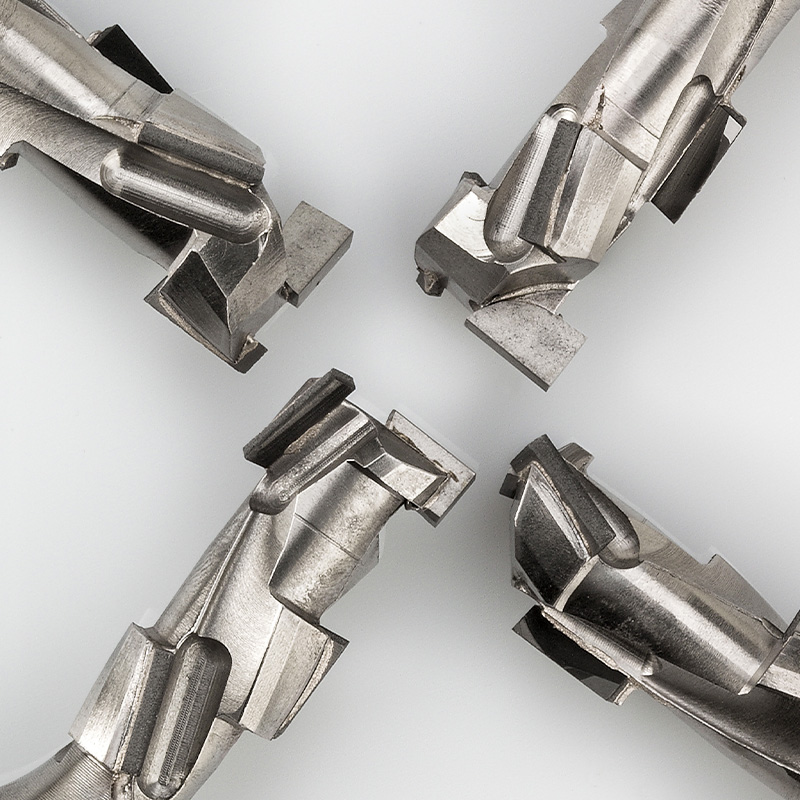Cutting tools can be made from different material according to their final destination we can recognize carbides, ceramics, diamonds and Boron Nitrides.
Cemented carbide due to their high non-metal content, are difficult to braze using conventional brazing filler metals. You must also reduce metallurgic interaction between the metallic binder matrix and the carbide as well as the generation of thermally induced tension.
The majority of brazing filler metals for cemented carbides are silver based as they have a relatively low melting point and can be done without any specific fluxes or methods.
Trefoil (a sandwich of brazing filler metals with an interlayer of copper foil) are usually processed by induction heating in normal atmosphere use to absorb stress that may occur at the cooling stage. While FH 10-type general-purpose fluxes are the standard choice, special flux grades of type FH 12 may be used. Flame brazing is not very common.
Accurately controlling the brazing temperature is a must. If Brazing small pieces of cemented carbide, you can opt for the low-melting silver-based brazing filler metals T99 or T99S with brazing temperature is approx. 20°C lower than that T520N.
| Joint | Tool Steel Carbides |
|---|---|
| Alloys | T99 T99S T520N T500 Trimetallico |
| Fluxes | D26N D31NF D2 D2BLACK |
| Equipment | Induction (rarely Flame) |
Cemented carbides coated by PVD (Physical Vapour Deposition) with a layer of titanium carbide (TiC), titanium nitride (TiN) or titanium aluminium nitride (TiAlN), Zinc must be avoid Thus, cemented carbides intended for this kind of coating process should be brazed using a zinc-free silver-based brazing filler metal; for example T6426 or T6528.
| Joint | Tool Steel Carbides |
|---|---|
| Alloys | T6426 T6528 |
| Fluxes | – |
| Equipment | Belt or Vacuum Furnace |
Diamond & Polycrystalline diamond (PCD)
Diamonds provide excellent hardness and high thermal conductivity. Thus, the heat generated when cutting is immediately discharged from the cutting face. The big disadvantage of diamonds is their high Brittleness, at higher temperatures they easily react to carbide formers such as iron, nickel, cobalt, tungsten or chromium. This limits the use of diamond-doted tools to non-ferrous metals such as aluminium or copper and to non-metal materials such as glass and carbon fibre, carbides and stone.
There are numerous diamond variants natural or synthetic monocrystalline, polycrystalline diamonds (PCD). PCD is brazed to the tool as compacted segments sometimes sintered onto a cemented carbide substrate or depositing by CVD method.
Under specific thermal and pressure constraints, diamonds will change their crystalline structure or may oxidise. At temperatures above 600°C, for example, diamonds and atmospheric oxygen react to produce CO2. At higher temperatures, diamonds may also convert back to graphite or, depending on process conditions, even as low as 750°C to generate a significant graphite share. The wetting of diamonds largely depends on the interaction of the diamond and the material it is in contact with.
The best way for brazing diamonds is active brazing filler metals, active elements such as titanium or zirconium react to the non-metal, inorganic materials, e.g. diamond or ceramics, the process must carried out in a vacuum or in an inert gas atmosphere.
| Joint | Tool Steel Diamond PCD |
|---|---|
| Alloys | T600A T6014A T600AW |
| Fluxes | – |
| Equipment | Vacuum Furnace |
Cubic boron nitride & Polycrystalline cubic boronnitride (PcBN)
Cubic boron nitride (cBN) is the second-hardest known material. It is used in a similar way to diamonds. cBN is brittle when exposed to impact loads. Owing to its very slow reaction to iron, nickel and cobalt alloys, cBN may be used to process these elements. It does, however, respond quickly to materials such as titanium and zirconium under formation of nitrides or borides.
Cubic boron nitride cBN is a lot more resistant to oxidation than diamond. An oxide layer protects it up to a temperature of 1,300 °C. cBN is chemically extremely stable which is why it cannot be brazed using conventional brazing filler metals, thus, just like diamonds, it is normally processed using active brazing filler metals based on a silver-copper-titanium system.
Nickel-based brazing filler metals cannot be used.
| Joint | Tool Steel cBN |
|---|---|
| Alloys | T600A T6014A T600AW |
| Fluxes | – |
| Equipment | Vacuum Furnace |
PcBN brazing should be performed at as low a temperature as possible to prevent coming off the cemented carbide substrate. Brazing in a vacuum is used occasionally.
| Joint | Tool Steel PcBN |
|---|---|
| Alloys | T99 T99S T520N T500 |
| Fluxes | D26N D31NF D2 D2BLACK |
| Equipment | Induction |
| Joint | Tool Steel PcBN |
|---|---|
| Alloys | T6426 T6528 |
| Fluxes | – |
| Equipment | Belt or Vacuum Furnace |
Ceramic tools are made from ceramic raw material powders which are formed into the target shape, compacted and then baked. Various routes are available, depending on the type of ceramics and intended use.
The use of active brazing alloy will be possible also using composition that overpass the 750°C.
| Joint | Ceramic – Ceramic |
|---|---|
| Alloys | T651A T700A T688A |
| Fluxes | – |
| Equipment | Vacuum Furnace |

